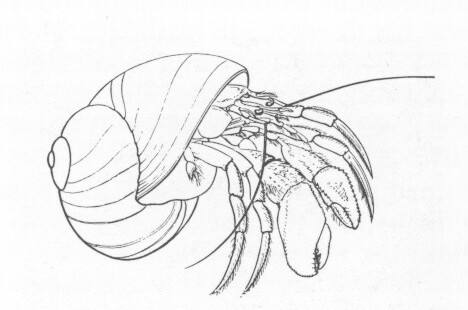- Introduction
- ES Morse
- Morse in New England
- Morse as an illustrator
- Morse in Japan
- Morse's pottery collection
- Charles Otis Whitman
- Shosaburo Watase
- Umeko Tsuda and Sutematsu Yamakawa
- Katsuma Dan
- Emperor Showa (Hirohito)
- Shinya Inoue
- Osamu Shimomura
- Susumu Honjo
- --------
- E.S. Morse Institute
- Institutional Cooperation
- Fukushima
- About
E.S. Morse in New England
Edward Sylvester Morse was a brilliant, energetic and engaging man, a curious and keen observer of all around him. In his teens he collected, drew, and identified snails and other shells/mollusks native to New England, in the process discovering one tiny species never before seen. Throughout his life he continued to observe, collect, carefully illustrate, and publish. During the early part of his life his publications and lectures focused on marine biology, by the time he reached age 50 he had become one of this country's experts on the culture of Japan.

Hermit crab by E.S. Morse.
.jpg)
Illustrations by E.S. Morse from Plate XXIII from Report on the Invertabrata of Massachusetts.
When Morse was 21, his skills of collecting, illustrating and classifying marine animals had attracted the attention of the world-famous and charismatic professor of natural history Louis Agassiz, who invited Morse to be his student assistant at Harvard in his new Museum of Comparative Zoology. He worked and studied there for several years, until a serious disagreement with Agassiz who did not believe in the theory of evolution, recently popularized by Darwin.
In 1867 several classmates from Harvard's museum joined Morse in establishing the collections and exhibits at the museum in Salem, Massachusetts, today known as the Peabody Essex Museum. They collected, catalogued, and curated exhibits of marine species from around the world. Starting in 1870, Morse was engaged in teaching at three colleges: Maine State College in Orono, Bowdoin, and Harvard, sequentially.
Morse's talents extended to being a brilliant and engaging lecturer. He continued his rigorous speaking schedule throughout his life.
In 1873, Agassiz invited Morse to be his assistant at his new summer school on the island of Penikese, on the Elizabeth Island chain, just off-shore from Woods Hole. There Morse met other people who were caught by Agassiz's enthusiasm, and all became firm believers in his expression "Study nature, not books", convinced that collecting, teaching and observing live specimens was best. Students from Agassiz's school went on to become the founders of marine laboratories across the country.
Morse became fascinated with Brachiopods. Only a few species still lived in the waters off New England. While Morse was on a speaking tour to California, he heard that there were many species of Brachiopods living in the Pacific off the newly opened country of Japan, and he determined to go there to collect specimens, a decision which was to guide the rest of his life.